Eyewear frames are not just functional accessories; they are a blend of craftsmanship, precision engineering, and artistic design. Behind their sleek and stylish appearance lies a complex production process that involves multiple steps and skilled artisans.
In this article, we delve into the fascinating world of eyewear frame manufacturing, exploring the intricate processes that bring these fashion essentials to life.
- Design and Conceptualization: The journey of an eyewear frame begins with the creative process of design and conceptualization. Talented designers combine their artistic vision with market trends and customer preferences to develop unique frame shapes, styles, and aesthetics.
- Material Selection: The choice of materials plays a crucial role in determining the quality and durability of eyewear frames. Manufacturers carefully select materials such as acetate, metal alloys, or injection-molded plastics, considering factors like strength, flexibility, and hypoallergenic properties.
- Frame Cutting and Shaping: Once the materials are selected, the production process moves to frame cutting and shaping. Specialized cutting machines and tools precisely carve out the frame components according to the designer's specifications. This stage requires meticulous attention to detail to ensure consistent dimensions and proper alignment.
- Frame Assembly: The frame assembly stage involves joining the various components of the frame, including the temples, bridge, and front piece. Skilled craftsmen employ various techniques such as welding, soldering, or screwing to securely assemble the frame while maintaining its structural integrity.
- Surface Finishing: To achieve the desired appearance and texture, the frames undergo surface finishing treatments. This includes processes such as polishing, sanding, and buffing to smoothen rough edges, remove imperfections, and enhance the frame's overall finish.
- Quality Control: Throughout the production process, rigorous quality control measures are implemented to ensure that each eyewear frame meets the highest standards. Inspections are conducted at different stages, including material inspection, dimensional accuracy checks, and surface quality assessments, to identify any flaws or defects.
- Lens Integration: Eyewear frames are designed to accommodate lenses that correct vision or provide protection. The frames are carefully fitted with lenses, which may involve specialized techniques such as rimless mounting, grooving, or edge polishing to ensure a seamless integration.
- Final Inspection and Packaging: Before reaching the hands of customers, each eyewear frame undergoes a final inspection to guarantee its functionality, comfort, and visual appeal. Frames that pass the inspection are meticulously cleaned, labeled, and packaged, ready for shipment to retailers or directly to customers.
The production processes involved in crafting eyewear frames are a testament to the meticulous attention to detail, technical expertise, and dedication of artisans in the industry. From design conception to final inspection, every step in the manufacturing process contributes to the creation of high-quality, fashionable, and functional eyewear frames that enhance the vision and style of individuals worldwide.
The production flow of eyewear frames varies depending on the material used in their construction. Each material requires specific manufacturing processes and techniques to bring out its unique characteristics and properties. Click to explore Hala Optical's manufacturing processes for different types of eyewear frame.
Metal Eyewear Frame:
The production process of metal eyewear frames involves precision engineering and skilled craftsmanship. It begins with the selection of high-quality metal materials, such as stainless steel or titanium, known for their durability and corrosion resistance. The metal is then carefully cut and shaped into the desired frame design using advanced machinery and cutting-edge techniques.
One of the most crucial steps is the welding process, where various components of the eyewear frame are meticulously fused together to ensure structural integrity. Afterward, the frame undergoes polishing to achieve a smooth and refined finish. Additional treatments, such as plating or coating, are applied to enhance the frame's aesthetics and durability.
Injection Eyewear Frame:
The production of injection eyewear frames involves a different approach. It starts with the selection of premium injection materials, typically TR90, a lightweight and flexible thermoplastic known for its strength and resilience. The material is heated and injected into precise molds using specialized machinery.
During the injection molding process, the frames take shape with intricate details and precise dimensions. Once cooled and solidified, the frames are carefully removed from the molds. Post-processing steps, such as trimming and polishing, are performed to achieve the final desired appearance and smooth texture.
Acetate Eyewear Frame:
Acetate eyewear frames are renowned for their luxurious look and feel. The production process begins with sourcing high-quality cellulose acetate, a natural and renewable material derived from cotton and wood pulp. The acetate sheets are carefully layered to create the unique color combinations and patterns associated with acetate frames.
Next, the frames are precisely cut and shaped using CNC machines, ensuring consistency and accuracy in the design. Skilled artisans hand-finish the frames, refining the edges and polishing the surfaces to achieve a glossy finish.
To add durability and strength, metal reinforcements may be inserted into the temples and bridge. The hinges and other components are meticulously assembled to ensure a comfortable fit and smooth functionality. The acetate frames then undergo a thorough quality inspection before being ready for the market.
Each of these eyewear frame production processes showcases the dedication to craftsmanship and quality that renowned eyewear manufacturers like Hala Optical exhibit. Whether it's the elegant metal frames, the lightweight injection frames, or the sophisticated acetate frames, customers can trust in the durability, comfort, and style of these premium eyewear choices.
Below are some main processes for eyeglasses frame manufacturing.
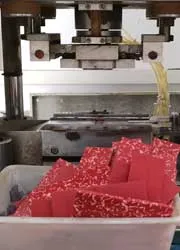
Cutting Acetate
Cut acetete sheet into rectangle plates, which is be used for CNC machine to make eyeglasses front or temples.

CNC Processing
Use CNC machine to engrave acetate plate into acetate front or temples.
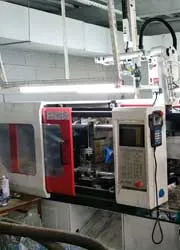
Injection
Inject plastic pallet into eyeglasses front & temple.

Coloring
Injected products coloring for special effect like fade, gradient.

Electroplating
Metal spare part plating, image shows plated temples.
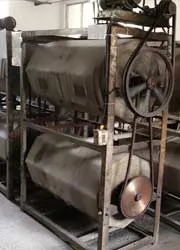
Tumbling
Semi products to be polished by tumbling, this may last for days.
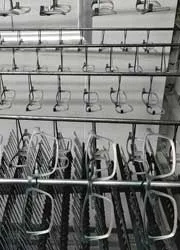
Drying
Eyewear products may need to be dried by heating, image shows injected front on rack in drying room.
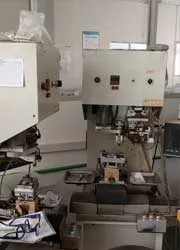
Hinge Assembling
The process to insert hinges into front, make the semi products suitable for assembling.
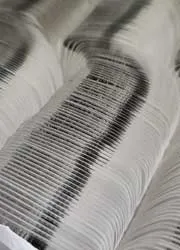
Lens Cutting & Printing
Demo lens or sunglasses will be cut, and print request content.
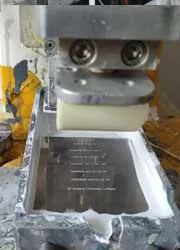
Printing
Eyeglasses frame to be printed with desired content, normally on temples or bridge.
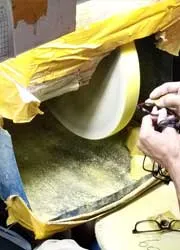
Hand Polishing
Polish by hand the frames before packing.

Packing
Eyeglasses are packed by requested materials. Image shows frames on rack waiting for packing.